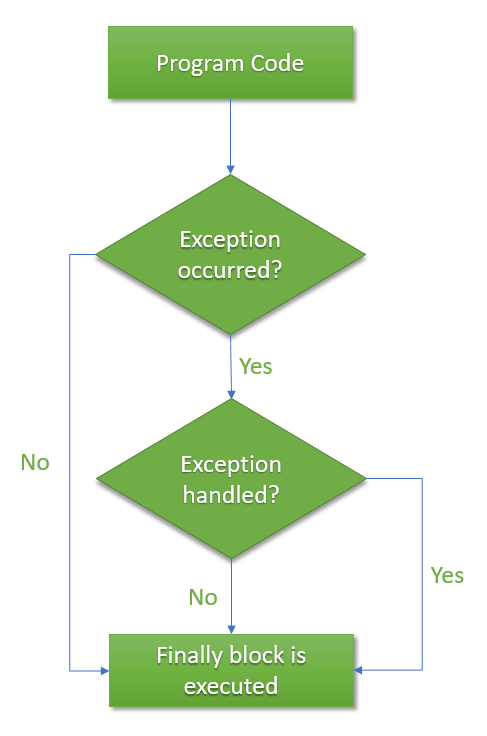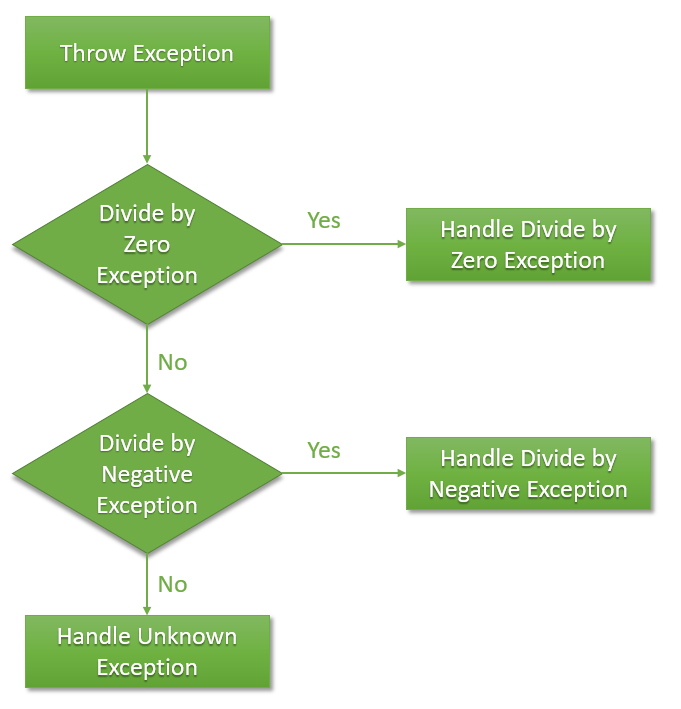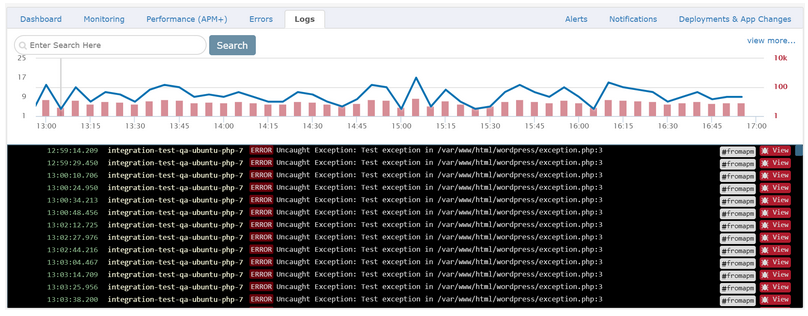
By TechnologyAzure and AWS Monitoring
By IndustryIntegrates with your stack
By InitiativeEngineering & DevOps Teams
TechnicalIt’s easy to get the help you need

When PHP version 5 was released, it incorporated a built-in model to catch errors and exceptions. Handling errors in PHP with try catch blocks is almost the same as handling errors in other programming languages.
When a PHP exception is thrown, the PHP runtime looks for a catch statement that can handle that type of exception. It will continue checking the calling methods up the stack trace until a catch statement is found. If one is not found, the exception is handed to the global exception handler that we will also cover in this article.

Exception handling is a mechanism in programming that allows a system to handle unexpected events or errors that occur during the execution of a program. These unexpected events, known as exceptions, can disrupt the normal flow of an application. Exception handling provides a controlled way to respond to these exceptions, allowing the program to either correct the issue or gracefully terminate.
While both error handling and exception handling deal with unexpected situations, they are conceptually different. Error handling typically deals with scenarios that can be anticipated and managed, such as a user entering invalid data. It often involves conditions and checks in the code to handle these situations. On the other hand, exception handling deals with unanticipated errors, like a network outage or a failed database connection. It involves a mechanism to “catch” these exceptions and handle them in a structured way.
Now, let’s move on to revising the content from the provided post.
When PHP version 5 was released, it incorporated a built-in model to catch errors and exceptions. Handling exceptions in PHP using try-catch blocks has become a standard practice, mirroring error handling in many other programming languages.
When a PHP exception is thrown, the PHP runtime system looks for a corresponding catch statement that can handle that specific exception type. It will continue to search through the calling methods up the stack trace until a suitable catch statement is found. If none is discovered, the exception is passed to the global exception handler, which we will delve into later in this article.
Here is an example of a basic PHP try catch statement.
try {
// run your code here
}
catch (exception $e) {
//code to handle the exception
}
finally {
//optional code that always runs
}

The following keywords are used for PHP exception handling.
PHP supports using multiple catch blocks within try catch. This allows us to customize our code based on the type of exception that was thrown. This is useful for customizing how you display an error message to a user, or if you should potentially retry something that failed the first time.
try {
// run your code here
}
catch (Exception $e) {
echo $e->getMessage();
}
catch (InvalidArgumentException $e) {
echo $e->getMessage();
}
In PHP version 5.5, the finally block was added. Sometimes in your PHP error handling code, you will also want to use a finally section. Finally is useful for more than just exception handling, it is used to perform cleanup code such as closing a file, closing a database connection, etc.
The finally block always executes when the try catch block exits. This ensures that the finally block is executed even if an unexpected exception occurs.
Example for try catch-finally:
try {
print "this is our try block n";
throw new Exception();
} catch (Exception $e) {
print "something went wrong, caught yah! n";
} finally {
print "this part is always executed n";
}
Below is the diagram showing how the program works.

PHP also allows creating custom exception types.This can be useful for creating custom exceptions in your application that you can have special exception handling around.
To create a custom exception handler, we must create a special class with functions that can be called when an exception occurs. The class must be an extension of the exception class.
class DivideByZeroException extends Exception {};
The custom exception class inherits the properties from PHP’s Exception class and you can add custom functions to it. You may not want to display all the details of an exception to the user or you can display a user-friendly message and log the error message internally for monitoring.
The sample below uses a custom PHP exception with multiple catch statements.
class DivideByZeroException extends Exception {};
class DivideByNegativeException extends Exception {};
function process_divide($denominator)
{
try
{
if ($denominator == 0)
{
throw new DivideByZeroException();
}
else if ($denominator < 0)
{
throw new DivideByNegativeException();
}
else
{
echo 100 / $denominator;
}
}
catch (DivideByZeroException $ex)
{
echo "Divide by zero exception!";
}
catch (DivideByNegativeException $ex)
{
echo "Divide by negative number exception!";
}
catch (Exception $x)
{
echo "UNKNOWN EXCEPTION!";
}
}
The code above throws an exception and catches it with a custom exception class. The DivideByZeroException() and DivideByNegativeException() classes are created as extensions of the existing Exception class; this way, it inherits all methods and properties from the Exception class. The “try” block is executed and an exception is thrown if the denominator is zero or negative number. The “catch” block catches the exception and displays the error message.
The flowchart below summarizes how our sample code above works for custom types of exceptions.

In a perfect world, your code will do proper exception handling. As a best practice, you should also configure a global PHP exception handler. It will be called in case an unhandled exception occurs that was not called in a proper PHP try catch block.
To configure a global PHP exception handler, we will use the set_exception_handler() function to set a user-defined function to handle all uncaught exceptions:
function our_global_exception_handler($exception) {
//this code should log the exception to disk and an error tracking system
echo "Exception:" . $exception->getMessage();
}
set_exception_handler(‘our_global_exception_handler’);
Logging is usually the eyes and ears for most developers when it comes to troubleshooting application problems. Logging exceptions so you can find them after they happen is a really important part of PHP error handling best practices.
Try Stackify’s free code profiler, Prefix, to write better code on your workstation. Prefix works with .NET, Java, PHP, Node.js, Ruby, and Python.
Error logs are crucial during development because it allows developers to see warnings, errors, notices, etc. that were logged while the application is running. That you can handle them appropriately through the PHP exception handling techniques try catch we just learned.
Depending on the PHP framework you are using, whether Laravel, Codeigniter, Symfony, or others, they may provide built-in logging frameworks. You can also use Monolog, which is a standard PHP logging library. Regardless of the logging framework you are using, you want to always log important exceptions being thrown in your code.
Here is a sample of a try/catch that logs errors with Monolog:
require_once(DIR.'/vendor/autoload.php');
use MonologLogger;
use MonologHandlerStreamHandler;
$logger = new Logger('channel-name');
$logger->pushHandler(new StreamHandler(DIR.'/app.log', Logger::DEBUG));
try {
// Code does some stuff
// debug logging statement
$logger->info('This is a log! ^_^ ');
}
catch (Exception $ex) {
$logger->error('Oh no an exception happened! ');
}
The PHP libraries for MySQL, PDO, and mysqli, have different modes for error handling. If you do not have exceptions enabled for those libraries, you can’t use try catch blocks. This makes error handling different and perhaps more complicated.
In PDO, you must enable ERRMODE_EXCEPTION when creating the connection.
// connect to MySQL
$conn = new PDO('mysql:host=localhost;dbname=stackifydb;charset=utf8mb4', 'username', 'password');
//PDO error mode to exception
$conn->setAttribute(PDO::ATTR_ERRMODE, PDO::ERRMODE_EXCEPTION);
Learn more about PDO attributes from the PHP docs.
For mysqli, you must do something similar:
mysqli_report(MYSQLI_REPORT_ERROR | MYSQLI_REPORT_STRICT);
Learn more from the MySQL docs.
Proper exception handling in PHP is very important. As part of that, you don’t want to simply log your exceptions to a log file and never know they occurred.
The solution is to use an error-tracking solution like Stackify’s Retrace. All errors are recorded together with some important details about that error, including the time it occurred, the method that caused it, and the exception type.
Retrace provides many important error-tracking and monitoring features. Including the ability to see all except in one place, identify unique errors, quickly find new errors after a deployment, email notifications about new errors, and much more.
Stackify’s error and log management tool can help you easily monitor and troubleshoot your application.

In this tutorial, we showed how to use PHP try catch blocks. We also covered some advanced uses with multiple exception types and even how to log all of your errors to a logging library. Good error handling best practices are critical to any PHP application. Retrace can help you quickly find and troubleshoot all of the exceptions being thrown in your code.
Stackify's APM tools are used by thousands of .NET, Java, PHP, Node.js, Python, & Ruby developers all over the world.
Explore Retrace's product features to learn more.
If you would like to be a guest contributor to the Stackify blog please reach out to stackify@stackify.com